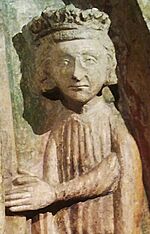Ottokar I of Bohemia facts for kids
Quick facts for kids Ottokar I |
|
|---|---|

Contemporary relief carving of Ottokar I in the tympanum of St George's Convent, Prague
|
|
| Duke/King of Bohemia | |
| Reign | 1192–1193 1200–1230 |
| Coronation | 1203, Prague |
| Successor | Wenceslaus I |
| Born | c. 1155 Bohemia |
| Died | 15 December 1230 (aged 75) Prague |
| Burial | St. Vitus Cathedral |
| Spouse | Adelheid of Meissen Constance of Hungary |
| Issue more... |
Wenceslaus I, King of Bohemia Dagmar, Queen of Denmark Anne, Duchess of Silesia Vladislaus II of Moravia Saint Agnes |
| Dynasty | Přemyslid |
| Father | Vladislaus II, Duke of Bohemia |
| Mother | Judith of Thuringia |
Ottokar I (Czech: Přemysl Otakar I.; born around 1155, died 1230) was an important ruler from the Přemyslid dynasty in Bohemia. He started as a Duke of Bohemia in 1192. Later, he became the King of Bohemia. He received this title from different Holy Roman Emperors, making it official and eventually hereditary for his family.
Contents
Becoming King of Bohemia
Ottokar's parents were Vladislaus II, Duke of Bohemia, and Judith of Thuringia. When he was young, Bohemia was a bit chaotic. After some fights, Emperor Henry VI recognized him as the ruler of Bohemia in 1192. However, Ottokar soon lost his position because he joined a group of German princes who wanted to challenge the Hohenstaufen family.
In 1197, Ottokar managed to get his brother, Vladislaus III, to give up Bohemia to him. His brother then ruled only Moravia.
Claiming the Crown
Germany was in a civil war at this time. Two powerful families, the Hohenstaufen and the Welf, were fighting for control. Ottokar used this chance to declare himself King of Bohemia in 1198. He was crowned in Mainz. Philip of Swabia, one of the German leaders, supported Ottokar. He needed military help from Bohemia.
In 1199, Ottokar divorced his wife, Adelheid of Meissen. He then married Constance of Hungary, who was the daughter of King Béla III of Hungary.
In 1200, Ottokar changed his support to Otto IV, another German leader. Both Otto IV and later Pope Innocent III agreed that Ottokar should be the hereditary King of Bohemia. This meant the title would pass down in his family.
The Golden Bull of Sicily
Ottokar had to switch his support back to Philip of Swabia for a short time. This happened because a new duke was declared for Bohemia. After some back and forth, Ottokar ended up supporting Frederick II.
In 1212, Frederick II issued a very important document called the Golden Bull of Sicily. This document officially recognized Ottokar and his future family members as the Kings of Bohemia.
What the Golden Bull Meant
- The King of Bohemia no longer needed the Holy Roman Emperor to appoint him.
- The Bohemian King only had to attend special meetings (called Diets) that were close to Bohemia's border.
- Even though Bohemia was part of the Holy Roman Empire, its king became a very important "electoral prince." This meant he had a say in choosing future emperors.
- The Bohemian King also had to provide 300 knights as bodyguards for emperors when they traveled to Rome for their coronation.
Changes in Bohemia
Ottokar's time as king also saw many changes within Bohemia. People from Germany started moving into Bohemia. New towns began to grow in areas that were once just forests.
In 1226, Ottokar had a conflict with Duke Leopold VI of Austria. This happened because Leopold ruined a plan for Ottokar's daughter, Saint Agnes of Bohemia, to marry Frederick II's son. Ottokar then tried to arrange for Agnes to marry Henry III of England. However, the emperor stopped this marriage because Henry was an enemy of the Hohenstaufen family. The emperor himself wanted to marry Agnes, but she chose to become a nun instead, with the help of the Pope.
Family Life
Ottokar was married twice.
First Marriage
In 1178, he married Adelheid of Meissen (who died in 1211). They had these children:
- Vratislav of Bohemia (died before 1225).
- Dagmar of Bohemia (died 1212), who married King Valdemar II of Denmark.
- Božislava of Bohemia (died before 1238), who married Count Henry I of Ortenberg.
- Hedvika of Bohemia, who became a nun.
Second Marriage
In 1199, he married Constance of Hungary (1181 – 1240). They had many children:
- Vratislav of Bohemia (born around 1200, died before 1209).
- Judith of Bohemia (died 1230), who married Bernhard von Spanheim, Duke of Carinthia.
- Anne of Bohemia (born 1204, died 1265), who married Henry II the Pious, High Duke of Poland.
- Anežka of Bohemia, who died young.
- Wenceslaus I of Bohemia (born around 1205, died 1253), who became the next King of Bohemia.
- Vladislaus of Bohemia (born 1207, died 1227), who was the Margrave of Moravia.
- Přemyslid of Bohemia (born 1209, died 1239), also a Margrave of Moravia.
- Saint Agnes of Bohemia (born 1211, died 1282).
See also
 In Spanish: Otakar I de Bohemia para niños
In Spanish: Otakar I de Bohemia para niños


